The stone shell of the Earth - the earth's crust - is firmly attached to the upper mantle and forms a single whole with it. The study of the earth's crust and lithosphere allows scientists to explain the processes occurring on the Earth's surface and predict changes in the appearance of our planet in the future.
The structure of the earth's crust
Earth's crust, consisting of igneous, metamorphic and sedimentary rocks, on the continents and under the oceans has a different thickness and structure.
In the continental crust, it is customary to distinguish three layers. Upper - sedimentary, which is dominated by sedimentary rocks. The two lower layers are conventionally called granite and basalt. The granite layer consists mainly of granite and metamorphic rocks. The basalt layer is made of denser rocks comparable in density to basalts. The oceanic crust is two-layered. In it, the upper layer - sedimentary - has a small thickness, the lower layer - basalt - consists of basalt rocks, and the granite layer is absent.
The thickness of the continental crust under the plains is 30-50 kilometers, under the mountains - up to 75 kilometers. The oceanic crust is much thinner, its thickness is from 5 to 10 kilometers.
The crust is found on other terrestrial planets, on the Moon and on many satellites of the giant planets. But only the Earth has two types of crust: continental and oceanic. On other planets, in most cases, it consists of basalts.
Lithosphere
The stony shell of the Earth, which includes the earth's crust and the upper part of the mantle, is called the lithosphere. There is a heated plastic layer of the mantle under it. The lithosphere seems to float on this layer. The thickness of the lithosphere in different regions of the Earth varies from 20 to 200 kilometers or more. In general, it is thicker under the continents than under the oceans.
Scientists have found that the lithosphere is not monolithic, but consists of. They are separated from each other by deep faults. Seven very large and somewhat smaller lithospheric plates are distinguished, which constantly, but slowly move along the plastic layer of the mantle. The average speed of their movement is about 5 centimeters per year. Some plates are completely oceanic, but most have different types the earth's crust.
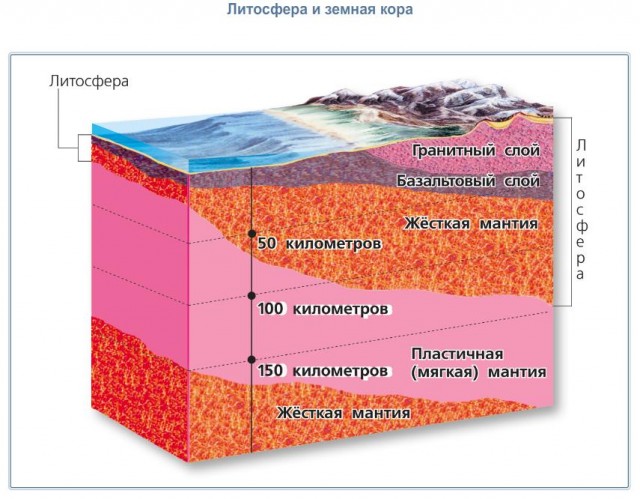
Lithospheric plates move relative to each other in different directions: either move away, or, conversely, approach and collide. As part of the lithospheric plates, their upper "floor" - the earth's crust, also moves. Due to the movement of lithospheric plates, the location of continents and oceans on the Earth's surface is changing. The continents now collide with each other, then move away from each other for thousands of kilometers.
Goal and tasks:
- Generate knowledge about internal structure Earth, about the method of its study.
- Show differences continental crust from the ocean crust.
- Show large lithospheric plates, folded areas; explain the essential features of the concept of "plate", predict changes in landforms as a result of the movement of lithospheric plates.
Equipment:
- physical World map,
- map “The structure of the earth and minerals”,
- drawing of the textbook,
- drawing in the atlas.
During the classes
I. Humanity has long wanted to know what is in the depths of the Earth. But finding out is not easy. So far, people have managed to drill a well only 15 km deep. Therefore, scientists have to explore the depths of the Earth using various instruments.
Today it has been possible to establish that the globe consists of three parts:
Kernels in the middle;
The mantle, which occupies 5/6 of the entire volume of the Earth;
The thin outer crust.
1. What is inside the Earth?
II. The upper solid shell of the Earth is called the lithosphere (from the Greek "lithos" - stone, "sphere" - a sphere, shell), which includes the earth's crust and the plastic viscous upper part of the mantle.
2. What is the lithosphere?
III. The upper solid shell of the Earth is called the lithosphere, and the uppermost part of the lithosphere is the earth's crust.
3. What is the structure of the earth's crust?
4. What are lithospheric plates?
IV. The entire earth's crust consists of lithospheric plates- individual stone blocks tightly adjacent to each other. They were constantly splitting and joining like pieces of a huge mosaic. Therefore, the outlines of continents and oceans have always changed and continue to change today.
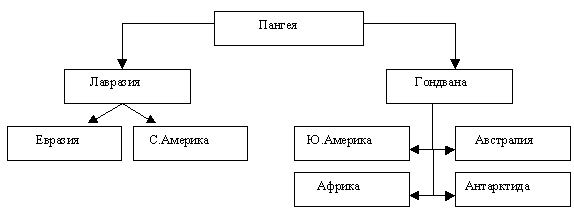
Streams of molten mantle material move lithospheric plates,
which move at a speed of about 5 cm per year. In places where the maytium material rises, the plates diverge, and the rising magma solidifies and fills the space between them. In the places where the maytium substance is lowered, the edges of the plates are crumpled into folds, creep and slide relative to each other, are sucked into the mantle and remelted. This is accompanied by earthquakes and volcanic eruptions.
V. The difference in the structure of the lithosphere is explained by the origin of our planet.
According to some ideas, the planet was formed from a single gas-dust cloud or nebula about 4.6 billion years ago.
According to another view, the Earth was formed from a gas-dust substance scattered in the space around the sun, which contained all the chemical elements known in nature.
Most scientists explain the differences in the structure of the earth's crust by the fact that at first the oceanic type crust was formed on the Earth. Under the influence of the processes taking place inside the planet, folds appeared on its surface, i.e. mountainous areas, the thickness of the crust increased, the heights of the continents were formed.
By the end of the 20th century, science was enriched with new data on the processes occurring in the bowels of the planets; the theory of lithospheric plates was created.
Hypothesis of the origin of lithospheric plates.
The earth's crust consists of large block-slabs with a thickness of 60 to 100 km. The boundaries between lithospheric plates run along mid-ocean ridges or deep-sea trenches. In the lithosphere, scientists identify 7-9 huge plates that move at a speed of 1 to 6 cm per year.
IV. The lithosphere is composed of rocks and minerals. Minerals- substances that are homogeneous in their properties, which usually form crystals of a strictly defined geometric shape. Rock Is a complex of various natural minerals. Rocks by origin are divided into igneous, sedimentary and metamorphic.
Igneous rocks are formed when the fiery liquid magma is cooled. Among them, melts and solutions of magmatic matter slowly solidified at different depths prevail.
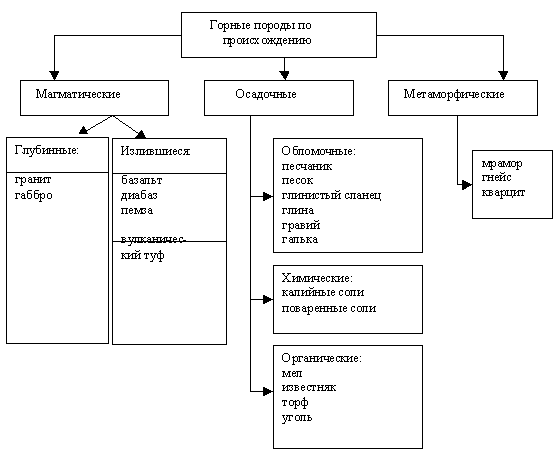
Sedimentary rocks are formed during the destruction of previously formed rocks on the Earth's surface under the influence of the sun, wind, water, living organisms and their accumulation (subsidence).
Metamorphic rocks are formed in the thickness of the earth's crust as a result of changes in the initial conditions of their occurrence. The reasons for their transformations can be changes in pressure, temperature in the bowels of the Earth.
6. Rocks that make up the earth's crust.
Vii. The earth's crust is in continuous motion, which manifests itself in different ways in different parts of it. The movement of the earth's crust is a natural phenomenon that occurs in the solid shell of the Earth.
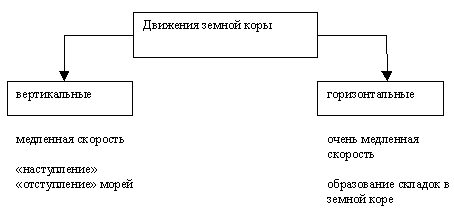
Mountainous areas experience uplifts, the speed of which is greater than the speed of uplift of the plains.
7. What types of movements are distinguished?
Sedimentary rocks formed towards the oceans, seas, lakes lie in horizontal layers: on top are younger rocks, below - more ancient. However, as a result of the movement of the earth's crust, this pattern is very often violated. Soft sedimentary rocks crumple into folds, hard rocks crack to form faults. Along the fault lines, some sections of the earth's crust rise, forming protrusions - horsts, others fall, resulting in depressions - grabens.
8. What are mountain grabens?
VIII. All processes and phenomena associated with the movement of magma in the earth's crust and on its surface are called volcanism... The phenomena of volcanism are widespread in the areas of interaction of lithospheric plates - at their junctions.

In the areas of active and extinct volcanoes, groundwater is heated by magma and can come to the surface in the form of hot springs. Such periodically gushing springs are called geysers.
The ground underfoot has always been a symbol of firmness and inviolability for a person. But sometimes even the earth's crust starts to move: there is earthquake... The place where the rupture and displacement of rocks occurs is called earthquake source... Plot earth surface under the focus of the earthquake is called the epicenter of the earthquake... Most earthquakes are confined to certain areas of our planet, which are called seismic belts.
9. What is the reason for the formation of volcanoes, earthquakes?
IX. The surface of the continents and the ocean floor has many irregularities. They all vary in height, size, shape, origin. Every uneven surface is landform... On land and under water, flat relief prevails over mountainous.

The relief is the result of the interaction of the internal and external forces of the Earth.
10. What is relief?
X. The largest landforms of the continents include vast plains and mountain ranges.
Plains- this is a part of the earth's surface with a difference in relative heights of no more than 200 meters.
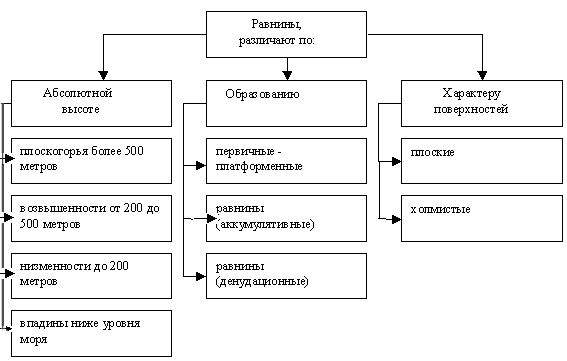
The relief of the land plain naturally transforms into the relief of the acquired sea plains. Their surface is dissected by cracks, hilly, divided by underwater ridges, plateaus, hills, as well as lonely standing mountains. The longest and deepest scars on the face of the lithosphere are confined to this part - deep gutters... (Pacific Ocean).
The mountains- it is a convex surface with a well-defined top, bottom, slopes.

The high parts of the mountains are called - peaks, and the pointed peaks - peaks.
Mountainous relief is common at the bottom of the oceans. The most important discovery of recent decades is mid-ocean ridges.
11. How are mountains and plains divided?
XI. The main reason for the variety of terrain is interaction
Internal and external processes act simultaneously. The relief is changing continuously and quite intensively.
The protrusions of the continents correspond to the continental crust, and in the areas of the distribution of the oceanic crust there are depressions filled with ocean water. Vast plains correspond to ancient sites of lithospheric plates - platforms. Mountain fold areas, deep-sea trenches on the ocean floor are located at the boundaries of the lithosphere plates.
12. What are platforms, folded areas?
Populating the table
"The relationship of internal and external processes that form the earth's crust."
| Process type | Manifestation in relief | The essence of the process |
| I. Internal: 1. Tectonic 2. Earthquake 3. Volcanism |
Formation of mountains, plains, gutters, median ridges. Formation of cracks, shifts, landslides. The formation of volcanoes, lava sheets. |
The combination of vertical and horizontal movements of the lithosphere, the appearance of folds and faults. Shocks and vibrations on the surface caused by ruptures and displacements in the lithosphere. Outpouring of magma onto the surface of the Earth. |
| II. External: 1. Weathering 2. The action of the wind 3. Action of water |
Formation of scree "stone rivers". Formation of sandy ridges, dunes, dunes. Formation of ravines, gullies, river deltas, seas, landslides. |
Destruction of rocks. Loose sediment transport by wind. Silt transfer by erosion of rocks by water. |
Anchoring.
In CO, fill in the table “Interrelation of internal and external processes”.
Homework.
Grade 7: page 41-52.
Grade 6: paragraph 16-22.
The Earth's crust, or geosphere, is the outer hard shell of the Earth. Under the bark is a mantle that differs from it in composition and physical properties. The structure of the mantle is denser, as it contains mainly refractory components. The boundary between the mantle and the crust is the Mohorovichich, or Moho, boundary, at which the speed of seismic waves sharply increases. Most of the crust is covered with hydrosphere on the outside, while the smaller part borders on atmospheric air. In accordance with this, the earth's crust is distinguished between oceanic and continental types, which have different structures. The total mass of the earth's crust, according to scientists, is only 0.5% of the total mass of the planet.
Structure and composition
The oceanic crust is dominated by the basalt layer. According to the theory of plate tectonics, this type of crust forms constantly in mid-ocean ridges, then moves away from them and is absorbed into the mantle in subduction areas. Therefore, the oceanic crust is considered relatively young. In different geographic areas the thickness of the oceanic crust varies from 5 to 7 km. It consists of basalt and sedimentary layers. Its thickness practically does not change over time because it depends on the amount of melt released from the mantle in the regions of the mid-oceanic ridges. Also, in part, the thickness of the oceanic crust is determined by the thickness of the sedimentary layer at the bottom of the oceans and seas. The thickness of the earth's crust increases with distance from areas of mid-oceanic ridges. The continental crust is characterized by a three-layer structure. The upper layer is a cover of sedimentary rocks, intermittent in places. This cover is well developed, but rarely very thick. The middle granite layer of the continental crust makes up most of the entire crust. It is composed of gneisses and granite, has a low density and ancient history education. A large proportion of the mass of these rocks was formed about 3 billion years ago. The lower basalt layer consists of metamorphic rocks - granulites and similar substances. The average thickness of the continental crust is about 35 km, the maximum under mountain ranges- 70-75 km. The bark of this species includes many chemical elements and their connections. About half of the mass is oxygen, a quarter is for silicon, the rest is for Al, Fe, Ca, Na, K, Mg, H, Ti, C, Cl, P, S, N, Mn, F, Ba.
In the transition zone from continents to oceans, a crust of a transitional (intermediate) type (suboceanic or subcontinental) was formed. The transitional crust is characterized by a complex combination of features of the earth's crust of the two types described above. The intermediate type crust corresponds to such areas as the shelf, island arcs, oceanic ridges.
In the overwhelming majority of regions, the earth's crust is in a state of relative isostatic equilibrium. Violation of isostatic compensation is observed on volcanic islands, oceanic depressions, and island arcs. Here the earth's crust is constantly subject to tectonic movements. Large faults in the earth's crust can be considered as a result of the shift of tectonic plates in the areas of their joints. Relatively calm areas (platforms) and mobile (folded belts) are distinguished in the structure of the crust.
Related materials:




